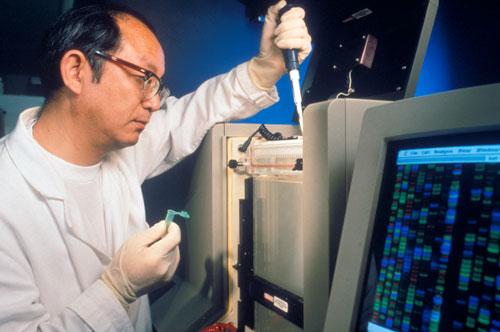African swine fever virus (Alonso et al. 2018)
African swine fever, African swine fever virus (ASF, ASFV)
First identified in Kenya in 1921 (Sánchez‐Vizcaíno et al. 2012)
Pathogen has not been detected in the U.S. (Brown and Bevin 2018)
Most likely pathway into the U.S. is the illegal importation of swine products or byproducts (APHIS)
Highly contagious and fatal viral disease affecting domestic and wild pigs; one of the most economically devastating diseases of swine (APHIS; Sánchez‐Vizcaíno et al. 2012)

Microbiologist Zhiqiang Lu uses a DNA sequencer to examine genetically engineered African swine fever viruses
Photo by Keith Weller; USDA, Agricultural Research Service
Find more images
Spotlights
Videos
All Resources
Selected Resources
The section below contains highly relevant resources for this species, organized by source.
Partnership
Federal Government
International Government
State and Local Government
Academic
Alonso, C., M. Borca, L. Dixon, et. al. 2018. ICTV Virus Taxonomy Profile: Asfarviridae. Journal of General Virology 99:613-614.
APHIS. Qualitative Assessment of the likelihood of African swine fever virus entry to the United States: Entry Assessment [PDF, 257 KB]. U.S. Department of Agriculture, Animal and Plant Health Inspection Service, Center for Epidemiology and Animal Health, Risk Assessment Team.
Brown, V.R., and S.N. Bevins. 2018. A review of African swine fever and the potential for introduction into the United States and the possibility of subsequent establishment in feral swine and native ticks. Frontiers in Veterinary Science 5:Article 11.
Sánchez‐Vizcaíno, J.M, L. Mur, and B. Martínez‐López. 2012. African swine fever: an epidemiological update. Transboundary and Emerging Diseases 59(s1):27-35.
